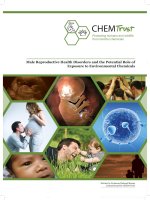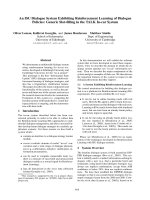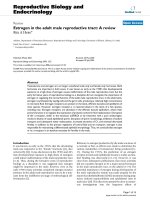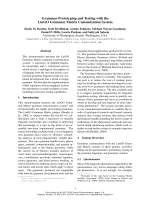Male Reproductive system pot
Bạn đang xem bản rút gọn của tài liệu. Xem và tải ngay bản đầy đủ của tài liệu tại đây (9.63 MB, 76 trang )
I. Male Reproductive system
II. Female Reproductive system
III. Sex Determination
IV. Modes of reproduction
V. Mating
Male Reproductive system
Testes
Vas Deferens
Seminal Vesicle
Accessory Glands
Ejaculatory duct
Aedeagus (Penis)
Gonopore (sperm exit)
Male Reproductive system
Testes
Usually paired structures
Each testis composed of (X) testicular follicles (sperm tubes)
Encased (usually) in connective tissue
Each Follicle individually encased in epithelial cells (thought to
serve a trophic function – nutritive)
Male Reproductive system
Ducts
Follicle - vas efferens - Vas deferens
Both of which lead to - Ejaculatory duct -
Penis - gonopore (typically associated w/
9
th
abdominal segment)
Seminal Vesicle: quiescent storage of
Spermatozoa
Examples of exceptions:
Protura, Ephemeroptera & some
Dermaptera:
Each vas deferens opens to exterior
Male Reproductive system
Accessory Glands:
Secrete seminal fluid w/ chemical
infusion for production of
spermatophores and activates
spermatozoa
Accessory Glands – Some influences of secretions (small peptides) on females:
-Stimulate muscle contraction of genital tract to facilitate sperm movement
-Stimulate oviposition
-Accelerate oocyte maturation
-Inhibit subsequent matings by formation of vaginal plugs (physical), or through
affecting behavior
Peptides seem pass into the hemolymph and are transported to targeted sites
Male Reproductive system
Spermatogenesis: The process of sperm maturation from germ cells to
spermatozoa
Usually occurs in last larval instar, or pupal stage and sometimes continues into
adulthood.
Male Reproductive system
(mechanical reproductive isolation)
•Pleiotropic effects
•Genitalic recognition
•Female choice
•Intersexual conflict
•Male-male competition
Crudgington, H.S. and M.T. Siva-Jothy. 2000. Genital
damage, kicking and early death. Nature 407:855-856
Female X Male Interactions in
Drosophila Sperm Competition
Andrew G. Clark, David J. Begun,
Timothy Prout
SCIENCE 283:217-220;
8 JANUARY 1999
Antagonistic coevolution between
the sexes in a group of insects.
Arnqvist G, Rowe L
NATURE
415 (6873): 787-789 FEB 14 2002
Female Reproductive Tract
Ovary
Accessory Glands
Spermatheca
Spermathecal gland
Gonopore
Vagina – Bursa Copulatrix
Female Reproductive Tract
Ovary
• Paired organs dedicated to egg
production
• Number of ovarioles vary greatly: 1-
2000
• Each ovarioles surrounded by
epithelial cells (which are invested w/
muscle and trachea)
• High O
2
demand associated w/ egg
maturation
Female Reproductive Tract
Zones in the Ovary
Germarium – contains developing 1
oocytes
Vitellarium – oocytes uptake nutrients
needed for a mature egg (yolk)
A host-parasite interaction rescues Drosophila oogenesis defects
Starr DJ, Cline TW. NATURE 418 (6893): 76-79 JUL 4 2002
Female Reproductive Tract
Accessory Glands
Vary extensively in function:
-Secrete adhesive materials
-Ootheca of Mantids and roaches
-aquatic gelatinous masses
-Teste fly modified to “milk glands”
which is used as food for
developing larvae
Female Reproductive Tract
Spermatheca – storage of sperm
Spermathecal gland – provide nourishment
Female Reproductive Tract
Gonopore
Usually located on 8
th
or 9
th
abdominal segment
Mature egg typically elongate and oval (Exceptions )
Majority of egg filled with yolk while the cytoplasm and nucleus is
a small portion
Egg may be encased in two layers;
Vitelline membrane (envelope)
Chorion (eggshell) when present act to conserve water
/>h_development/egg_structure.html









